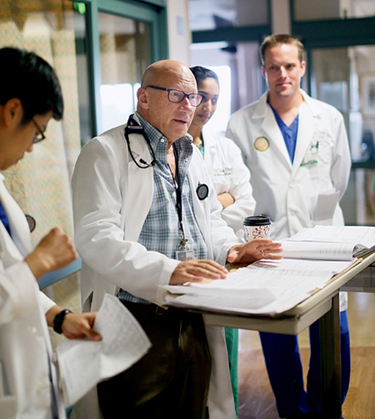July 2013—In his 25-year practice career, Texas obstetrician James Maher, MD, has performed several thousand amniocenteses, using a long needle to draw amniotic fluid from the uterus of higher-risk pregnant women to rule out certain fetal chromosomal abnormalities—trisomy 21, or Down syndrome, in particular.
Read More »July 2013
From the President’s Desk: Inclusion woven into our fabric
July 2013—The CAP Residents Forum, a voice for pathology residents and an effective agent of change, will celebrate its 25th anniversary at CAP ’13. Forty-two residents attended the first CAP Residents Forum in October 1988. Last year, 218 delegates from 116 training programs came to the meeting, a remarkable fivefold increase.
Read More »Heart failure high-wire act
July 2013—After weeks of bewilderment, W. Frank Peacock, MD, finally solved the mystery of one of his so-called frequent fliers in the Emergency Department.
Read More »Sooner, smarter—new strategies against sepsis
July 2013—When it comes to fighting sepsis, the ingenuity of the laboratory is indispensable.
Read More »Expressions follow SCOTUS gene ruling
July 2013—The U.S. Supreme Court last month handed down a landmark decision on a narrow issue with broad implications for molecular medicine: Can genes be patented? In ruling that as products of nature, genes did not meet the criteria for patent eligibility, the Court brought its collective wisdom to bear on an issue that has troubled physicians, ethicists, and patients for nearly 20 years and hindered innovators in academia and industry. The Court declared invalid the patents on the genes BRCA1 and BRCA2, patents that were at the heart of an intellectual property estate that enabled Myriad Genetics to create a commercial monopoly in BRCA testing.
Read More »Test utilization: a united front against waste
July 2013—When it comes to laboratory test orders, the connection between bloodletting and financially draining an institution is more than metaphorical. But a wide range of techniques can help stem test overutilization, clinical laboratory experts have found; you don’t have to drive a stake through a vampire’s heart to stanch the flow.
Read More »Newsbytes, 7/13
July 2013—BtB Software marketing compliance relationship management system; Congressman introduces health IT innovation bill; CCHIT releases information technology guide for ACOs
Read More »Q & A, 7/13
July 2013—Can you clarify the difference between the terms “optimization,” “validation,” and “verification” as used in immunohistochemistry? These three terms relate to the processes that the laboratory must undertake before new diagnostic, prognostic, or predictive immunohistochemistry markers are used for clinical and/or pathologic decisionmaking.
Read More »Put it On the Board, 7/13
July 2013—The FDA approved Abbott’s hepatitis C virus genotyping test for use in the United States. The RealTime HCV Genotype II test differentiates genotypes 1, 1a, 1b, 2, 3, 4, and 5 and is run on the automated m2000 platform. Gavin Cloherty, PhD, Abbott Molecular’s director of scientific affairs, told CAP TODAY the test has a 99.5 percent accuracy relative to sequencing and a greater than 99 percent discrimination of HCV genotype 1 subtype 1a versus 1b. Time to result for 22 samples and two controls, he said, is 5.25 hours, with 30 minutes hands-on time.
Read More »AMP v. Myriad Genetics: the end of the beginning
July 2013—The most remarkable fact about the June 13 decision of the Supreme Court in Association for Molecular Pathology v. Myriad Genetics, ___ U.S. ___ (2013), is that both sides are proclaiming victory. The physicians and geneticists who challenged efforts to enforce patents on the BRCA1 and BRCA2 genes are elated that the Court has squarely held that “a naturally occurring DNA segment is a product of nature and not patent eligible merely because it has been isolated.”
Read More »Anatomic Pathology Selected Abstracts, 7/13
July 2013—Intraoperative pathologic examination in the era of molecular testing for differentiated thyroid cancer: Diagnostic thyroidectomy is typically indicated for indeterminate thyroid cytology results. Traditionally, intraoperative pathologic examination (IOPE) helped guide the extent of initial surgery. Preoperative molecular testing of fine-needle aspiration cytology has emerged as another diagnostic adjunct, is highly specific for thyroid cancer, and can lead to appropriate initial total thyroidectomy.
Read More »Clinical Pathology Selected Abstracts, 7/13
July 2013—Risk factors for first venous thromboembolism around pregnancy: Venous thromboembolism is a serious maternal complication occurring at a rate of one to two per 1,000 maternities during pregnancy and the puerperium. Venous thromboembolism (VTE) is a leading cause of maternal mortality in developed countries and an important source of morbidity in the form of post-thrombotic syndrome.
Read More » CAP TODAY Pathology/Laboratory Medicine/Laboratory Management
CAP TODAY Pathology/Laboratory Medicine/Laboratory Management




